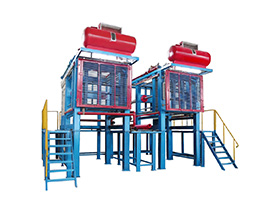What is the process of EPS shape molding?
The process of EPS (Expanded Polystyrene) shape molding is a widely used technique for manufacturing various foam products, including packaging materials, insulation panels, and even decorative elements. This process involves several key steps:
EPS Bead Pre-expansion: The process begins with EPS beads, which are small, unexpanded polystyrene pellets. These beads are initially exposed to steam in a pre-expansion chamber. The application of steam causes the beads to expand, increasing their size and reducing their density. This pre-expansion step is critical to achieving the desired foam density for the final product.
Aging: After pre-expansion, the expanded EPS beads are left to age for a specific period. This aging process allows the expanded beads to stabilize and ensures consistent molding results.
Mold Preparation: While the beads are aging, molds are prepared for the specific shape and size of the desired foam product. These molds can be made of various materials, such as aluminum or steel, and are often coated with a release agent to prevent the foam from sticking to the mold surfaces.
Mold Closing: Once the molds are ready, they are closed and securely sealed. Some molding machines use a vacuum to hold the molds closed during the molding process.
Bead Filling: The aged and expanded EPS beads are then loaded into the closed molds. Depending on the desired foam density and shape, a precise quantity of beads is dispensed into the mold cavity.
Molding and Steam Injection: The closed molds, filled with EPS beads, are introduced into a molding machine. Steam is injected into the mold, causing the beads to further expand and fuse together, forming the desired foam shape. The heat and pressure from the steam are crucial for shaping and bonding the beads.

Cooling and Solidification: After the molding process, the molds are cooled using either air or water to rapidly solidify the foam inside. This cooling phase helps set the shape and prevents deformation.
Mold Opening: Once the foam product has sufficiently cooled and solidified, the molds are opened, and the newly formed foam product is ejected. The release agent applied earlier prevents the foam from sticking to the mold surfaces, facilitating easy removal.
Trimming and Finishing: In some cases, the foam product may require trimming or cutting to achieve the desired final shape. This step can be performed manually or with automated equipment. Additionally, any excess material is often recycled for future use.
Quality Control: The final foam product undergoes quality control checks to ensure it meets the specified standards for density, dimensions, and appearance. Defective or substandard products are typically discarded or recycled.
Packaging and Shipping: Once the foam products pass quality control, they are ready for packaging and distribution to customers or further processing, depending on their intended use.
EPS shape molding is a highly versatile and cost-effective manufacturing process, producing foam products with excellent insulation properties, lightweight characteristics, and a wide range of shapes and sizes. It is widely used in industries such as packaging, construction, and automotive due to its ability to create customized, low-density foam solutions with minimal material waste.
223
0
0

Comments
All Comments (0)